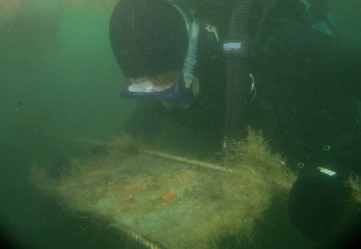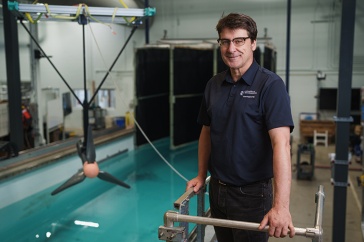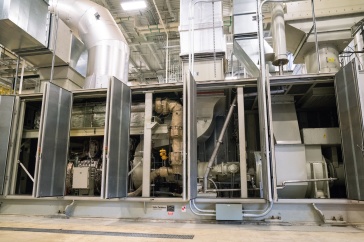
Tunicates, or sea squirts, like these in Portsmouth Harbor will proliferate as waters warm.
They’re lovingly called "sea squirts," but these marine soft-bodied animals, or tunicates, could cause a giant-sized problem in cold water areas like the Gulf of Maine.
New UNH research indicates that with a water temperature increase of two degrees Celsius (or 3.6 degrees Fahrenheit) predicted in the coming years, the invasive tunicate species Botrylloides violaceus will be able to double its reproduction rates in places like Portsmouth Harbor, in Portsmouth, New Hampshire, and in Eastport, Maine. This seemingly modest increase will allow B. violaceus to occupy even more space on natural and artificial surfaces, crowding out native species and potentially creating problems for aquaculturists who work along the northern New England coast.
“We’ve seen their populations spread northeastward in the past decade. So our first question was, what changed during that time period to cause this invasive species to take hold and spread?”
“We’ve seen their populations spread northeastward in the past decade, where there are now much larger colonies than before in places like Eastport and the colonies have spread to the natural substrate,” says Jennifer Dijkstra, UNH research assistant professor of biological sciences at the UNH Center for Coastal and Ocean Mapping, who led the N.H. Sea Grant-funded study published recently in the journal Diversity and Distributions. “So our first question was, what changed during that time period to cause this invasive species to take hold and spread? We know from our own research and others’ that water temperatures have increased during that time. Then we wanted to know if that change can drive the future success of this tunicate species.”
Tunicates live in underwater colonies by the hundreds. Originally from Asia, the B. violaceus species was first discovered in the Gulf of Maine in the early 1980s, but since then has infiltrated the rocky underwater landscape. These yellow-orange blobs are now established in rocky areas with native plant species, and they use a glue-like substance to attach to just about any surface, including the ocean floor, piers, fishing gear, and other marine plants — even on the invasive seaweeds that have made their home near the Isles of Shoals. And like many invasive species, once they’ve settled in an area, it’s tough to get rid of them.
For those who make their living on the water, this may come as no surprise. Oyster farmers in Great Bay sometimes use power sprayers to remove tunicates that grow on their oyster bags, costing additional time and added expense to the farming operation. Laying the bags in the sun for a couple of hours can also help to kill the tunicates, according to Michael Chambers, aquaculture specialist for N.H. Sea Grant and UNH Cooperative Extension. This form of eradication can help to some extent on the local scale, but their regional population trends have continued on an upward trajectory — and researchers say this trend is likely to continue given the findings of this study.
This first-of-its-kind research incorporates current and predicted maximum and seasonal water temperatures in the model to estimate future reproductive rates of B. violaceus. The study is also a demonstration in the value of long-term scientific data sets: Ocean temperatures recorded by buoys throughout the Gulf of Maine over the past thirty years, coupled with visual observations and meticulous data collection from the research team over more than a decade provided detailed data inputs for the computer models to more accurately predict the reproductive rates of B. violaceous. Long-term field studies that began while Dijkstra was a graduate student at UNH helped to corroborate the model’s results.

Study author Jennifer Dijkstra researches invasive tunicates in Portsmouth Harbor.
“We didn’t expect to see this amount of change over the past decade,” says Erica Westerman, assistant professor of biological sciences at the University of Arkansas and co-author on this research. She worked closely with Dijkstra as a UNH graduate student and saw first-hand the spread of B. violaceus. “It’s amazing to be able to see the effect of these relatively small changes in maximum temperature on species abundance and community composition,” she added. Larry Harris, UNH professor of biological sciences, is also a co-author on the study.
Although temperature is the driving factor in B. violaceus reproductive rates, it isn’t the only factor: Salinity, food availability and space also play lesser roles, Dijkstra says. Nevertheless, the model predicts B. violaceus will be able to reproduce three times per year in Salem Harbor, Massachusetts, twice a year in Portsmouth Harbor, and once per year in Eastport with just a small increase in maximum water temperature.
“We have known this invasive tunicate is in the Gulf of Maine and our research shows that it will likely become more common,” Dijkstra says. “So we should look at other mitigation strategies on the local scale.”
In addition to NH Sea Grant, funding for this study was provided by National Estuarine Research Reserve System (grant/award number: NOAA NA06NOS42000033), Piscataqua Region Estuaries Partnership (PREP) and NERRS Fellowship (grant/award number: NA06NOS4200003). N.H. Sea Grant promotes the wise use, conservation and sustainable development of marine and coastal resources in the state, the region and beyond. Located at the University of New Hampshire, NHSG is part of a national network of programs located in our coastal and Great Lakes states as well as in Puerto Rico and Guam.
-
Written By:
Rebecca Irelan | Institute for the Study of Earth, Oceans, and Space | rebecca.irelan@unh.edu | 603-862-0990
-
Compiled By:
Beth Potier | UNH Marketing | beth.potier@unh.edu | 2-1566
















































